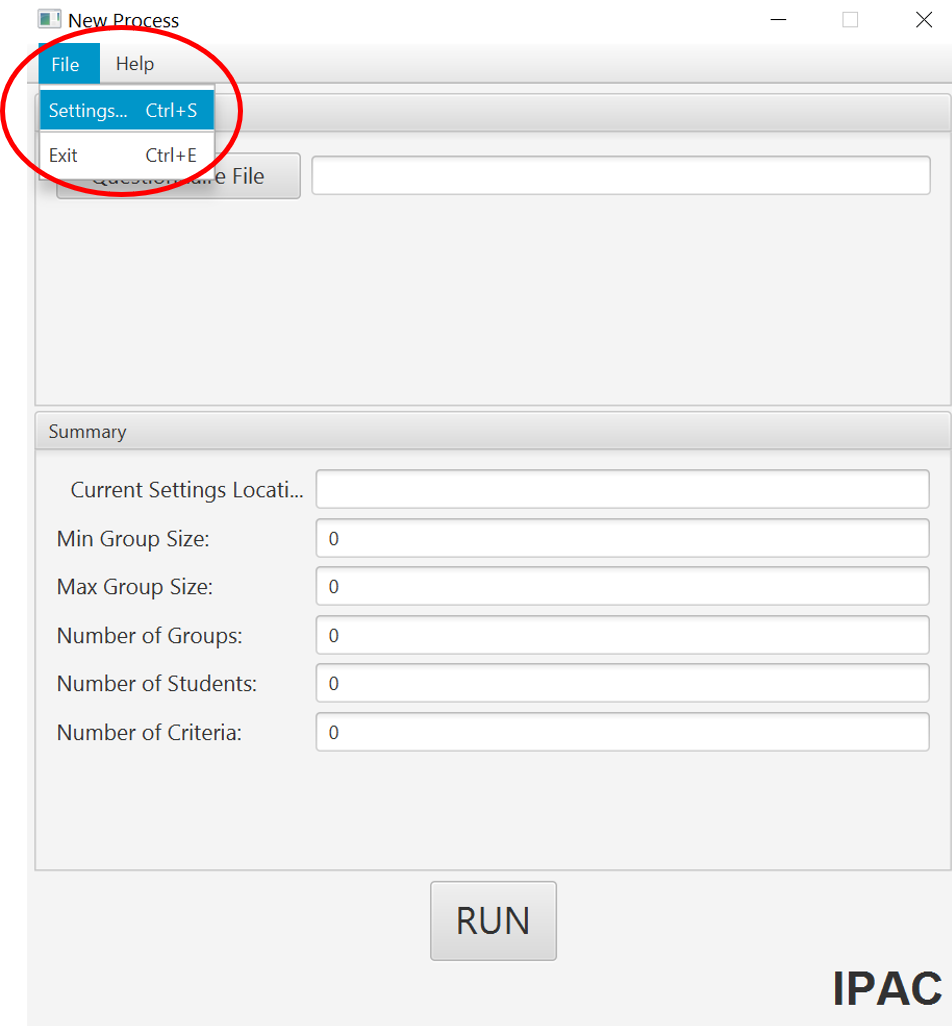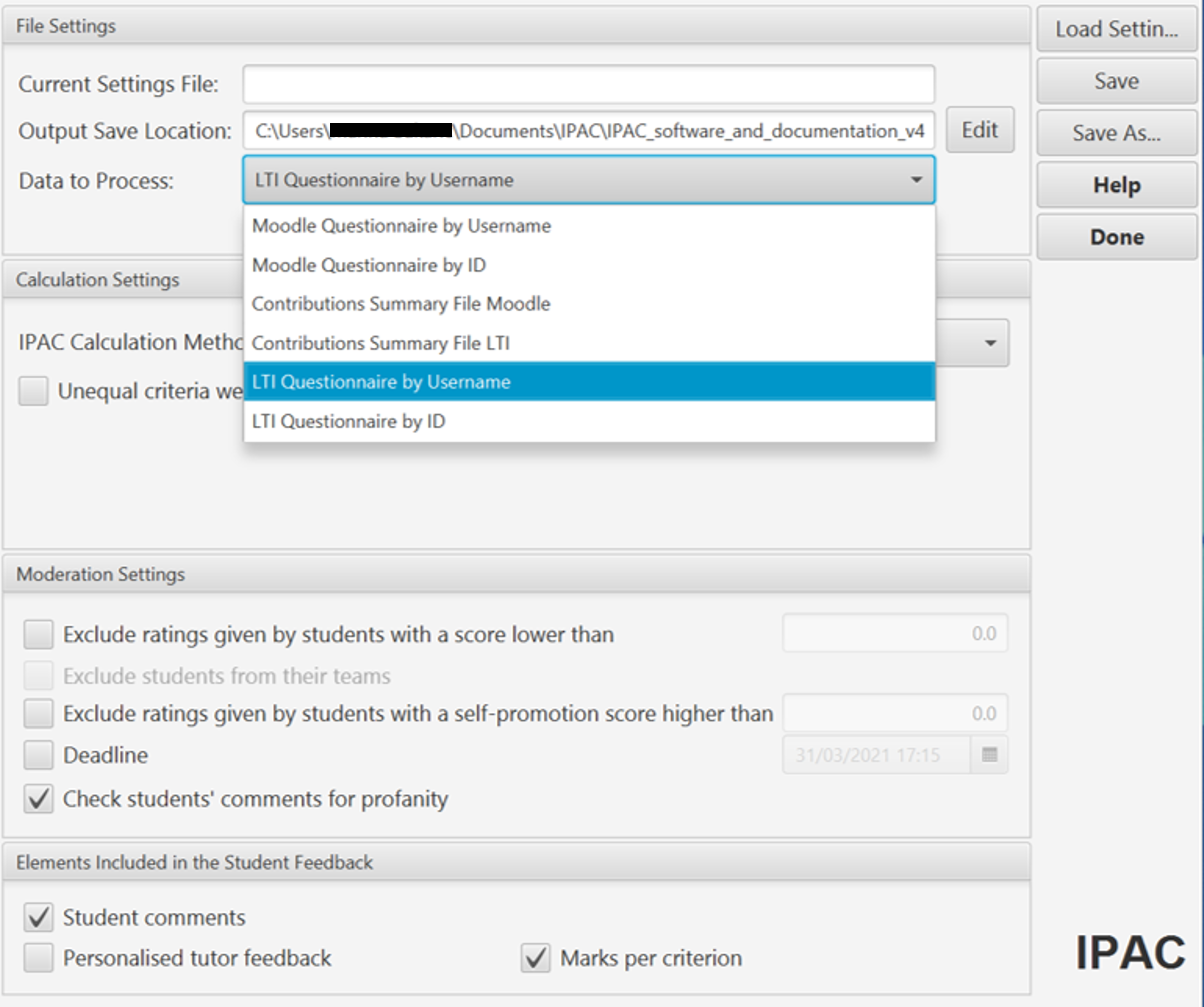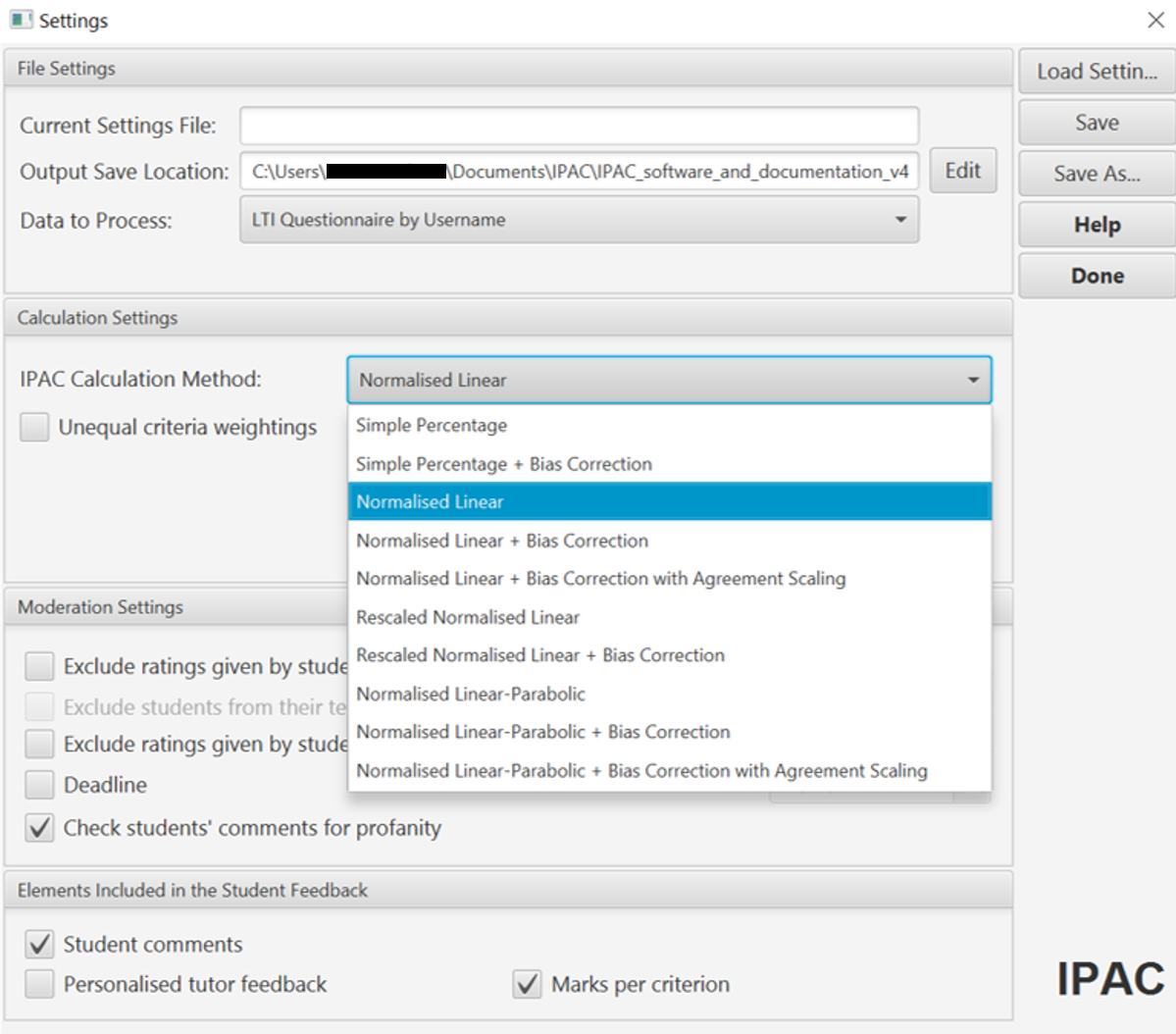IPAC Software: Settings
See the full process in the video, or the step-by-step explanation below.
The IPAC tool settings can be modified by clicking File -> Settings (or Ctrl+S). Here, the analysis of the file containing the raw data can be customised and saved as a custom settings file (.ser) by clicking on the ‘Save’ (in the directory containing the IPAC software) or ‘Save as’ (in a user-defined directory) button.

File Settings
The ‘Settings’ page has four sections. ‘File Settings’ determines the type of input file being processed, as well as the location where the files are saved. By default, the files are saved in the same location as the IPAC software. There are several options to choose from regarding the input file type, depending on whether an ‘LTI Questionnaire’ was used or a ‘Moodle Questionnaire’, as well as an option for re-processing a previous file (‘Contributions Summary’). The files generated by the IPAC LTI and your VLE (such as Moodle) differ, so a correct option must be selected at this stage. Also, depending on the institution settings, two options will be available to identify the students by their username or ID.

Calculation Settings
In the following section, ‘Calculation Settings’, the IPAC method can be chosen, as well as the option for ‘Allowing for self-assessment’ and using ‘Unequal criteria weightings’. If necessary, the system will prompt you for more information specific to the method selected.
‘Normalised Linear’ outputs values around 1, with 1 being the average within a certain group. Values above 1 here indicate a student is over-performing, while below 1 indicates a student is under-performing an average student in that group.
When using ‘Simple Percentage’, the tutor needs to indicate how many assessment levels were used in order to calculate the value in percentage (%).
Other options include ‘Bias Correction’ that can be applied to both the ‘Normalised Linear’ and ‘Simple Percentage’. Here, an average mark that each student gives to themselves and their peers is mathematically balanced out with respect to other students’ marks. For more information on calculating the IPAC values, and consequently individual marks, see Menu > Data analysis with IPAC software > Numerical calculations .

Additional options:
- ‘Allow self-assessment’ enables the student to reflect on their own input, as well as their team. The scores the students give to themselves will not be automatically included in the calculations.
- ‘Unequal criteria weightings’ allows you to give each criteria (or question) a different weighting. The user is prompted to indicate the weighting of each question once the analysis is run. Please note that the sum of all the weights needs to be equal to 100 %.

Moderation Settings
In the ‘Moderation Settings’, the default settings include ‘Check students’ comments for profanity’. This setting is useful in case the feedback released to the students will include the comments from their peers. Note, however, the software will only indicate that such profanities exist and where they appear, and it is up to the tutor to censor or filter them out.
Other moderation options include ‘Exclude ratings given by students with a score lower than…’, where the score limit is set by the tutor. This setting filters out the ratings given by students that received low IPAC scores from their peers based on poor work engagement with their group. As such, these students cannot assess the contribution of their peers. The score limit will depend on the Calculation Settings used. For example, a tutor using Normalised Linear might decide IPAC = 0.50 is the lower limit in this case, meaning a contribution level equivalent to 50 % of the average in the group.
Another option related to the above is to ‘Exclude students from their teams’ if they have received an IPAC score lower than the defined lower limit. This is relevant when using Normalised Linear or any of its variations as a calculation setting. This should always be ticked for reasons described in Menu > Data analysis with IPAC software > ‘Numerical Calculations’ tab on this webpage.
Another option available is to ‘Exclude ratings given by students with a self-promotion score higher than…’ a value defined by the tutor, meaning that the IPAC calculation does not use the scores given by students who have marked themselves significantly higher than their peers on average. For example, setting up a threshold of 1.3 would filter out the scores given by students who gave 30 % higher marks to themselves than on average to their peers.
The tutor can also check whether the students have complied with the set submission deadline by ticking the option ‘Deadline’ and choosing the set date. The system will indicate for each student if they have submitted late, and how late.

Elements Included in the Student Feedback
This section allows the tutor to decide which elements will be included into the student feedback. Options include:
- ‘Student comments’ includes the student feedback given by their peers;
- Personalised tutor feedback’ for each student can be generated by the IPAC system from a database of pre-written tutor comments (for more information, see Menu > Data analysis with IPAC software > ‘Automatic personalised tutor feedback feature’;
- ‘Marks per criteria’ releases the average mark the student has obtained in each criteria. This is useful because a student might have done well in one criteria but not in the other, so this gives them more information on what they are doing well and where they need to improve.
